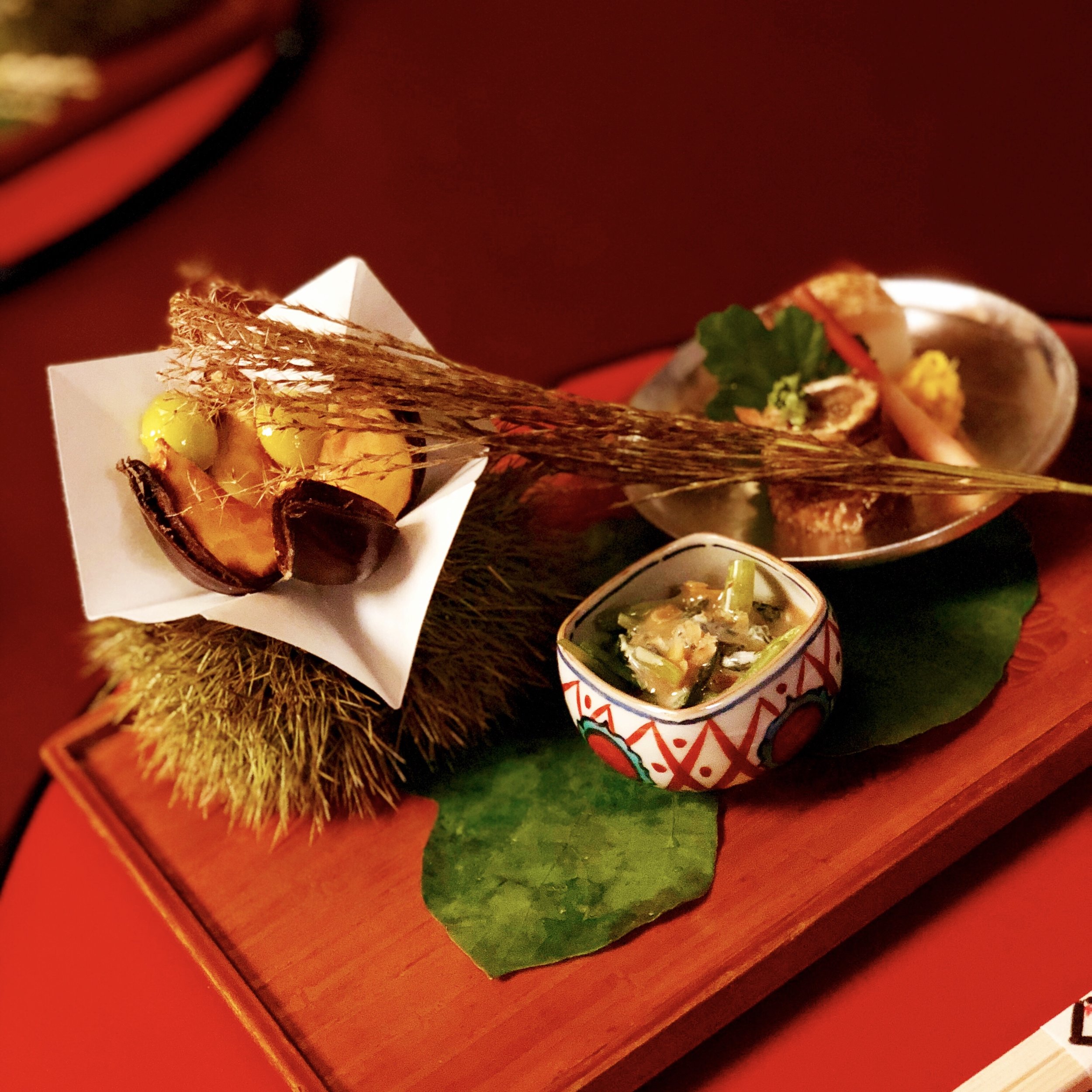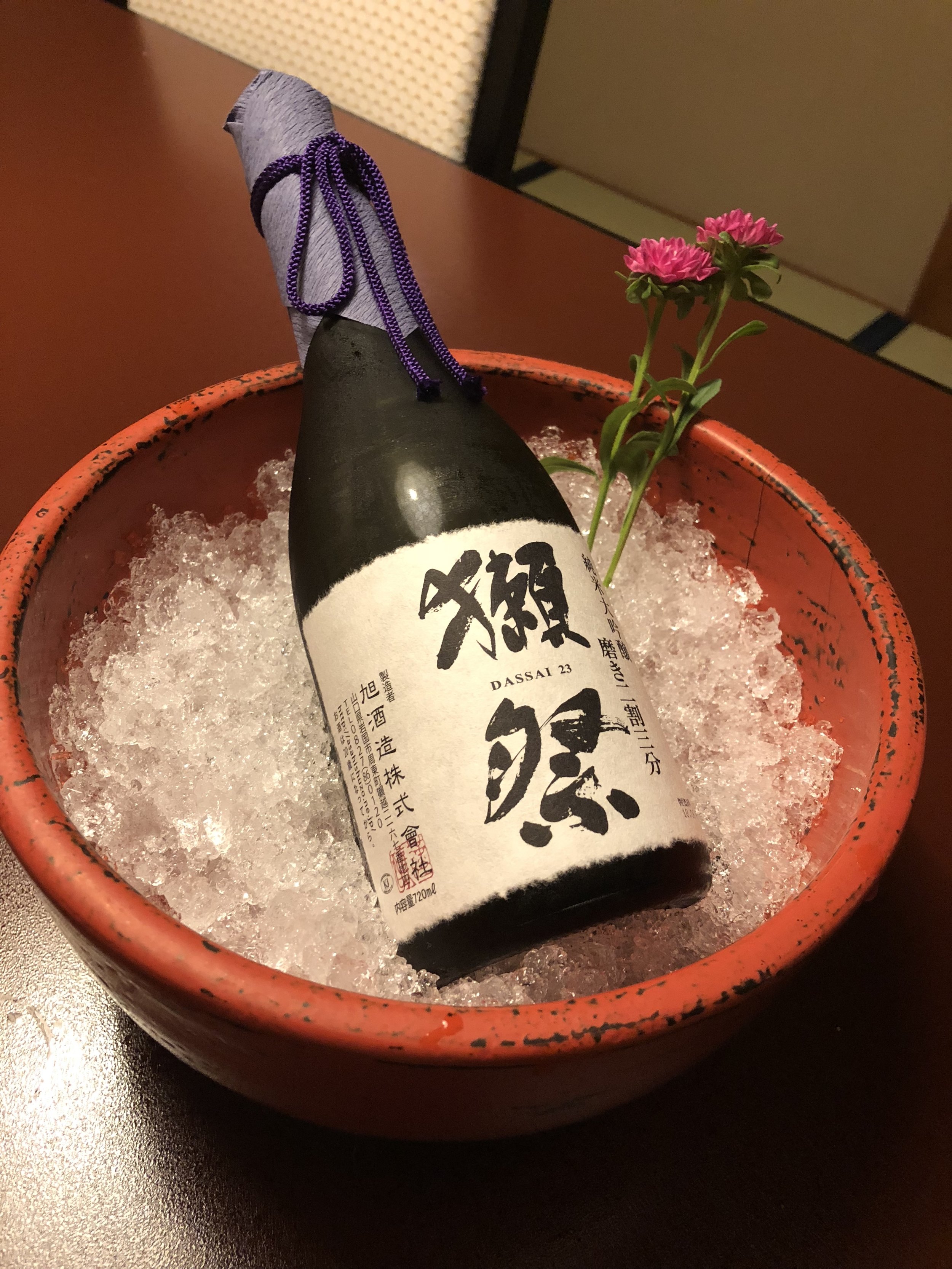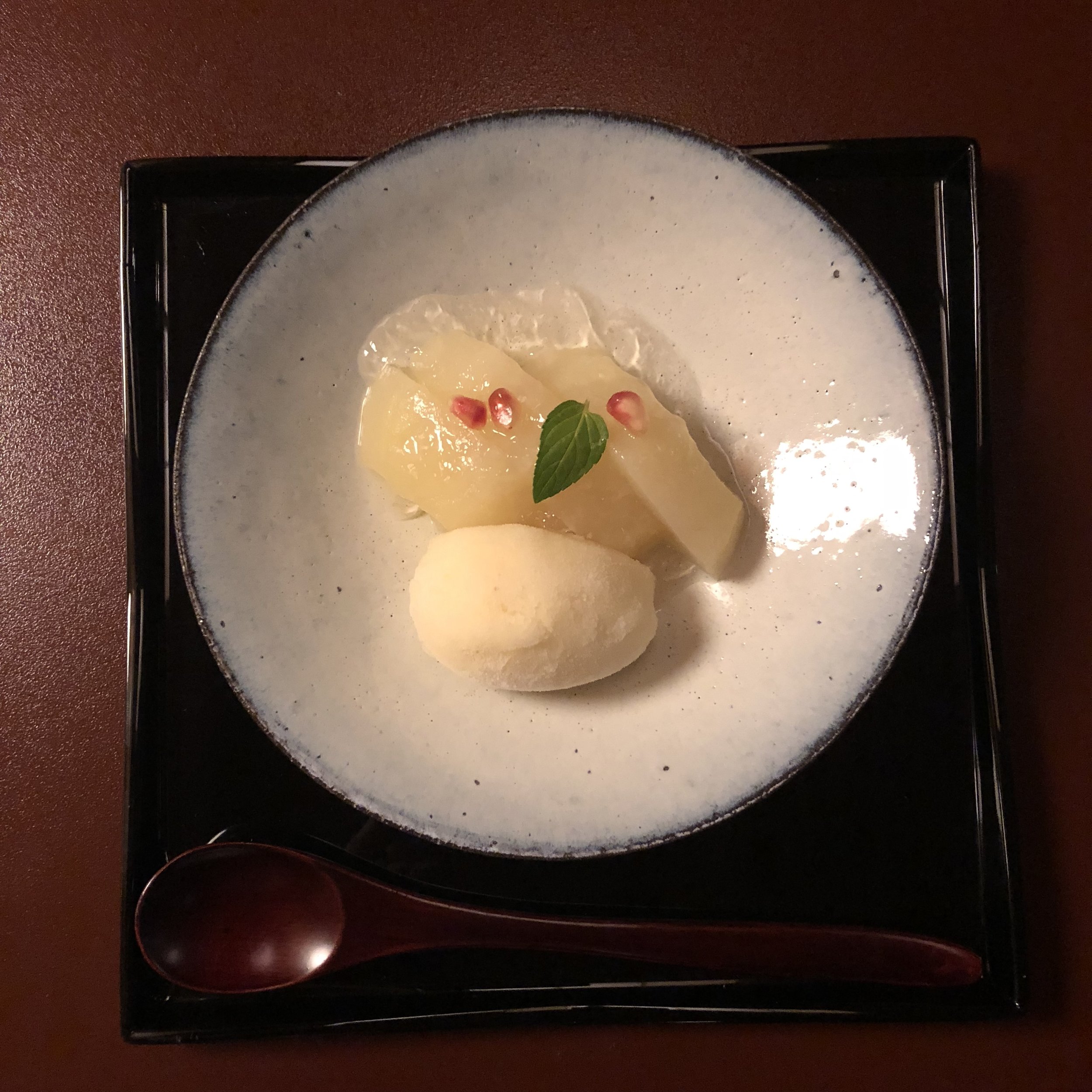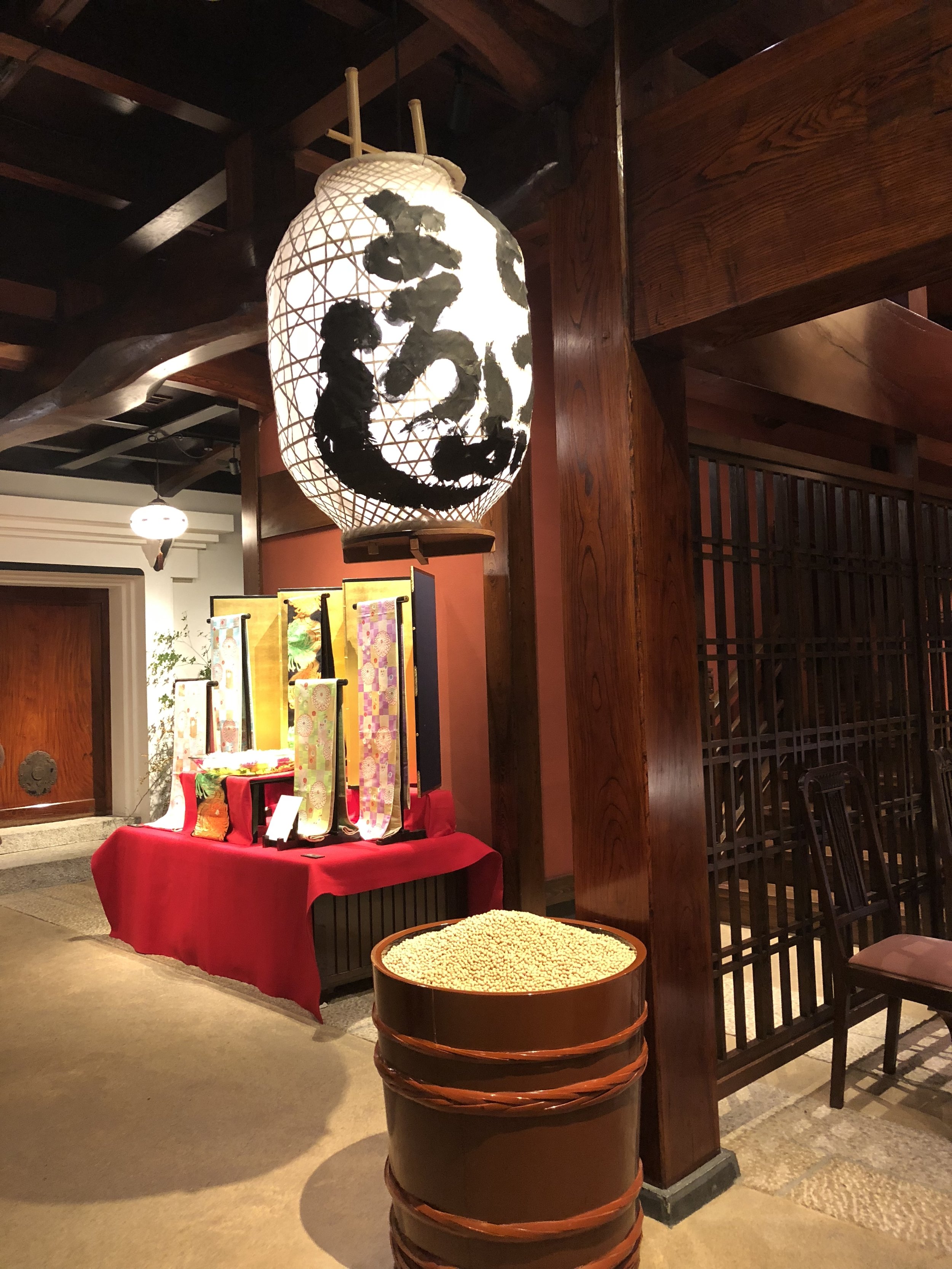Ben Greenfield in Tokyo #4
Kazumi (Sports Gain CEO), Ben and Tateki at Tokyo Shiba Tofuya Ukai
DAY4
Ben’s last day in Tokyo was so packed same as other days. We have been busy to enjoy, learn and experience Japanese culture in Tokyo and Ben started his last day in Ginza and took hours of private Japanese cooking lesson by a very well-know/trained chef, Ishizuka, the owner Ishizuka, as a head chef, found this restaurant after awarding Michelin stars for 5 consecutive years. I was a translator/camera man/guest for him. Ginza is famous for being a trendy hotspot, but it's also a downtown area with shops that were founded over a hundred years ago. Department stores and luxury boutiques line the route from Nihonbashi to Ginza. It's a long established tradition to shop and stroll while the road is closed to traffic. Luxury hotels, world class cuisine from talented chefs, and a
collection of glitzy clubs will make this area popular with anyone looking for a night out. The restaurant is small but neat and tidy.
Let’s see what Ben cooked!!
Private cooking class at Ishizuka Ginza
Ishizuka is an authentic Japanese restaurant. The owner chef creates "course of the day," listening to each customer's request. Using only superb ingredients such as vegetables and seafood that are just harvested or caught, each dish he creates is unique, and no identical dish will be served. It surely surprises even regular customers. Well, when I got note for cooking class, that explained everything. The menu Ben was going to learn and cook are all authentic Japanese dishes, but those are very seasonal and basic, but definately not for mom made or easy homemade dish. For some, Japanese cuisine has earned the reputation as being fussy, demanding the sourcing and preparation of complicated ingredients. Not so in the average Japanese household, where recipes are deceptively simple, can be recreated at speed and most importantly taste ever-so-good It was very professional, but somehow simplified/modified for Ben. just hats off to the chef.

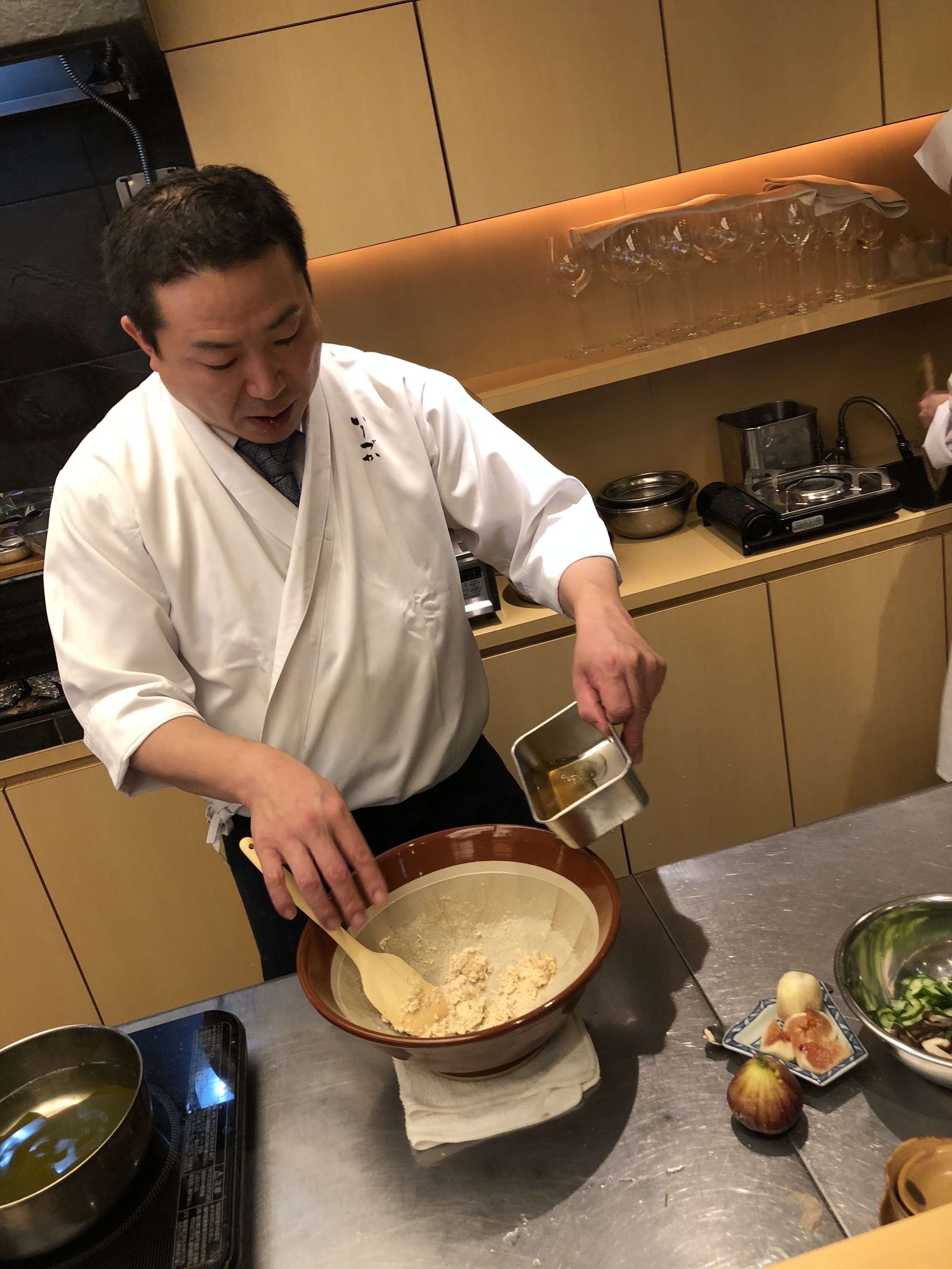
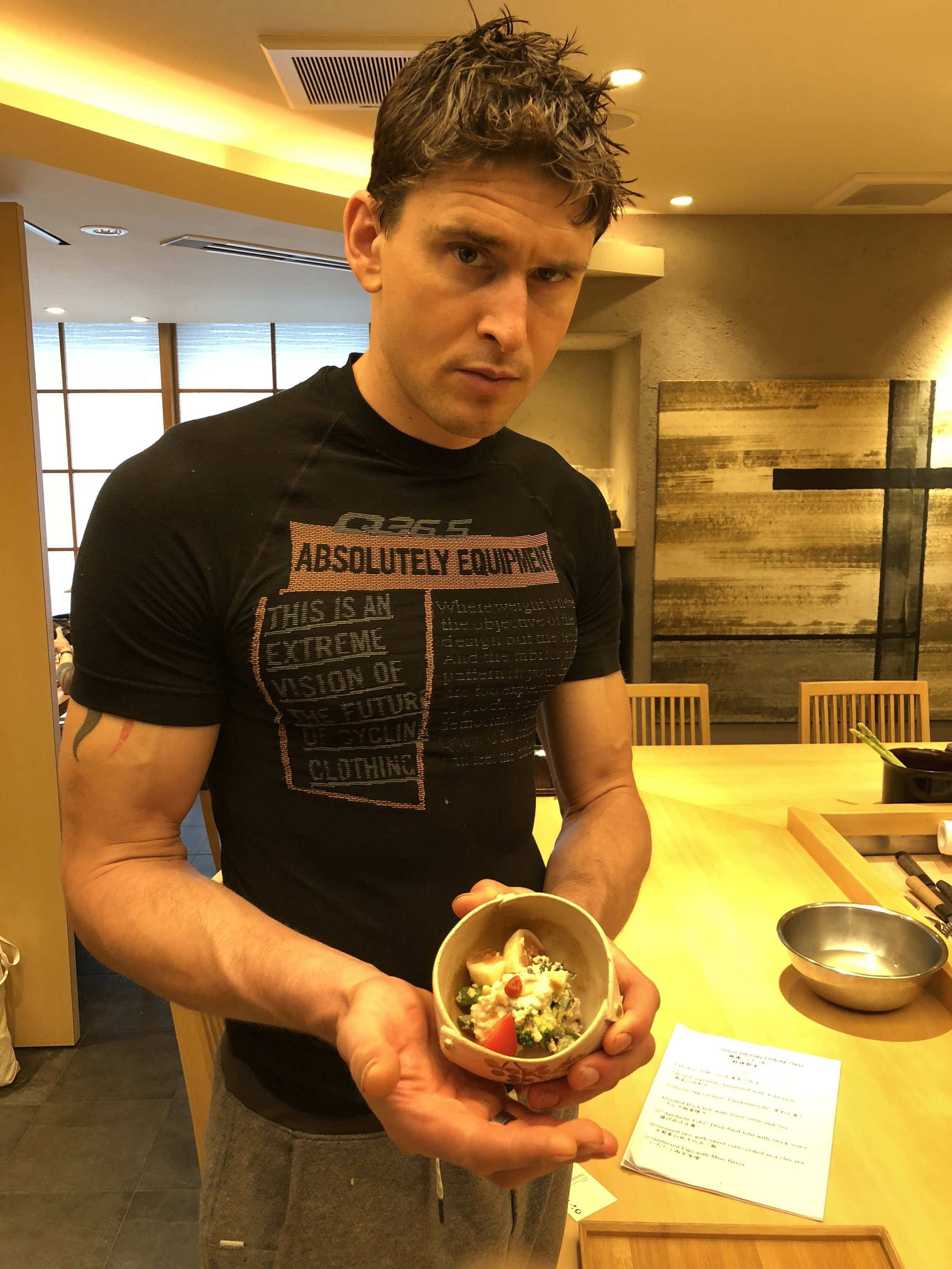

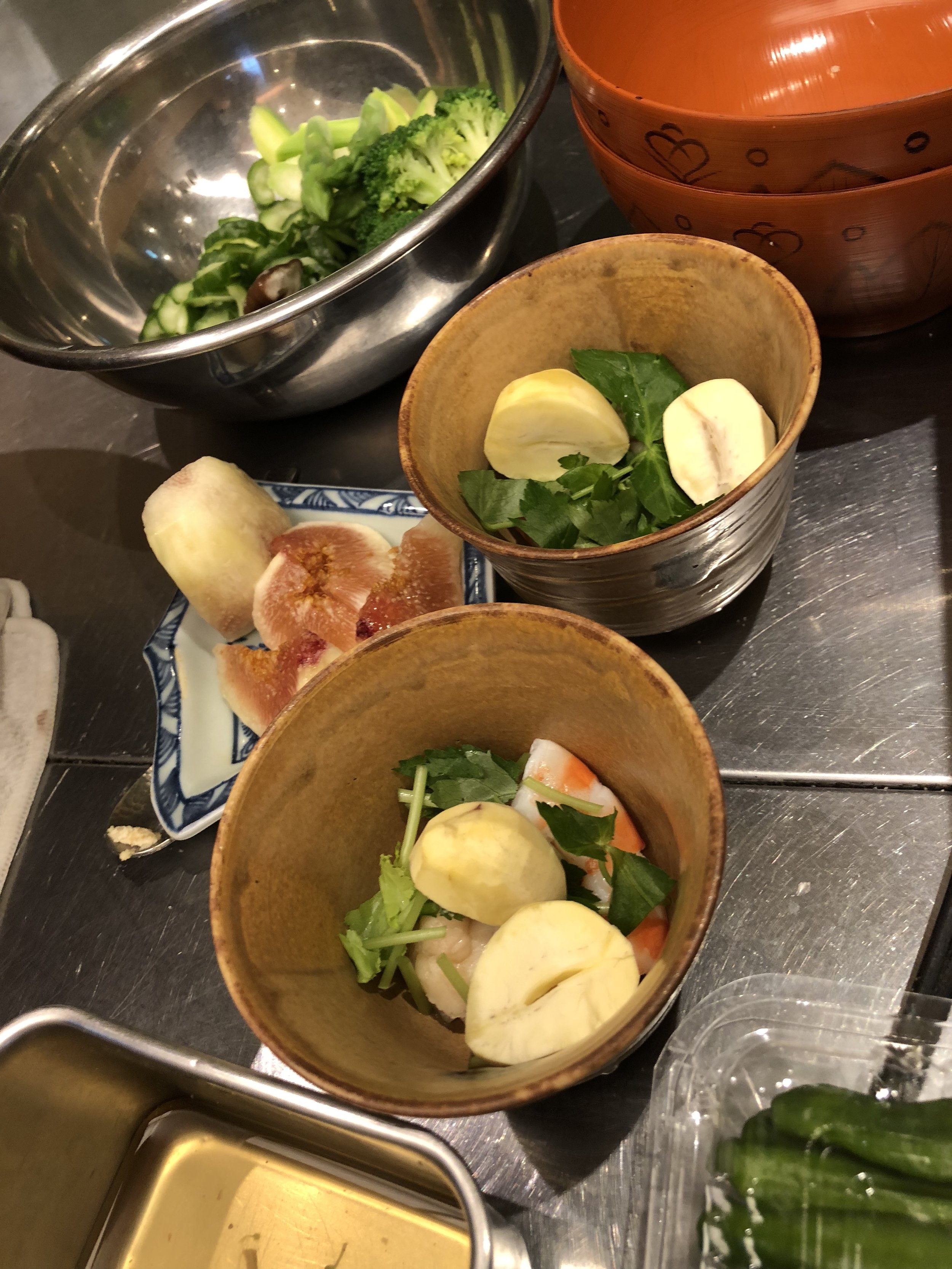

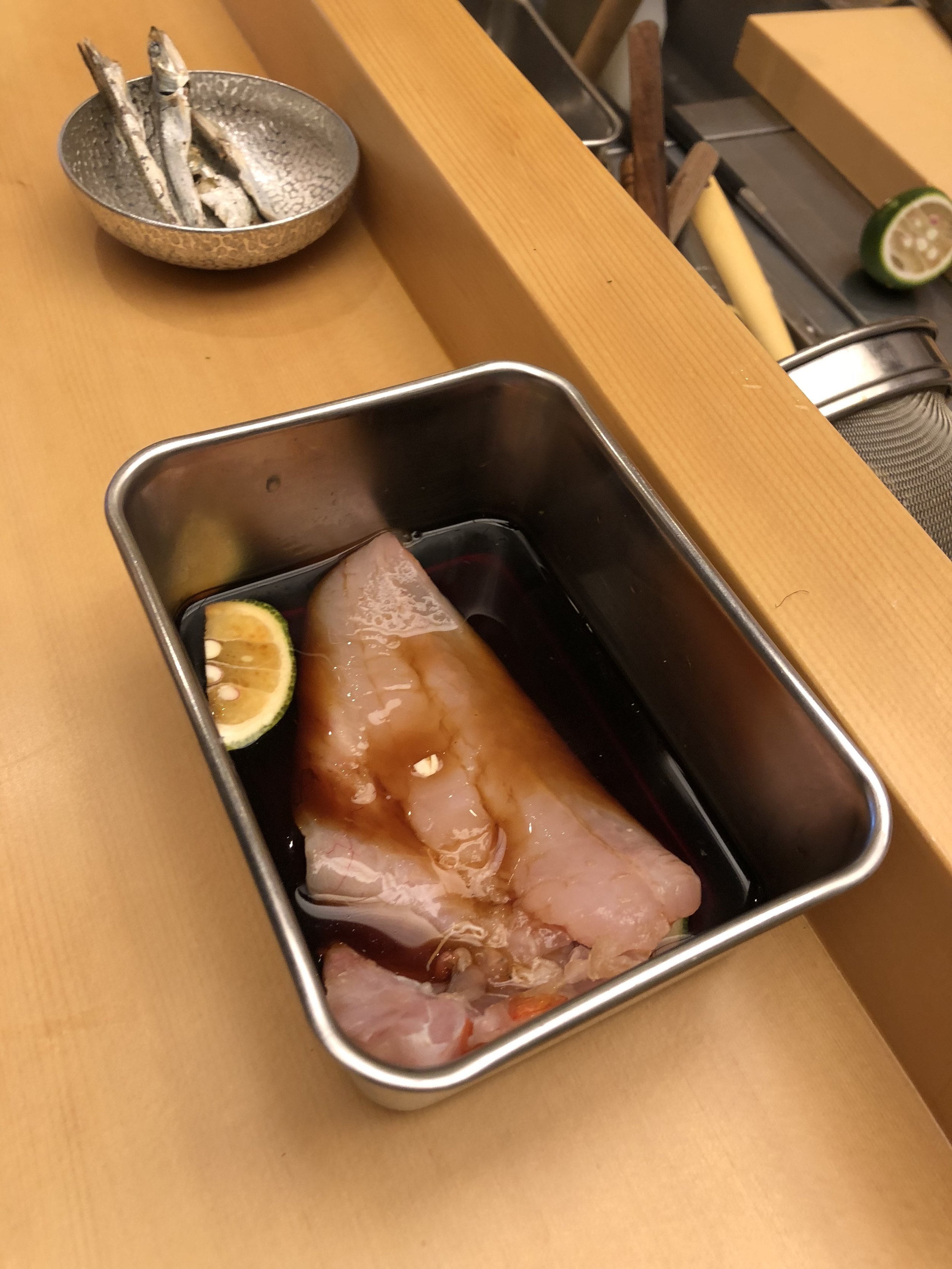

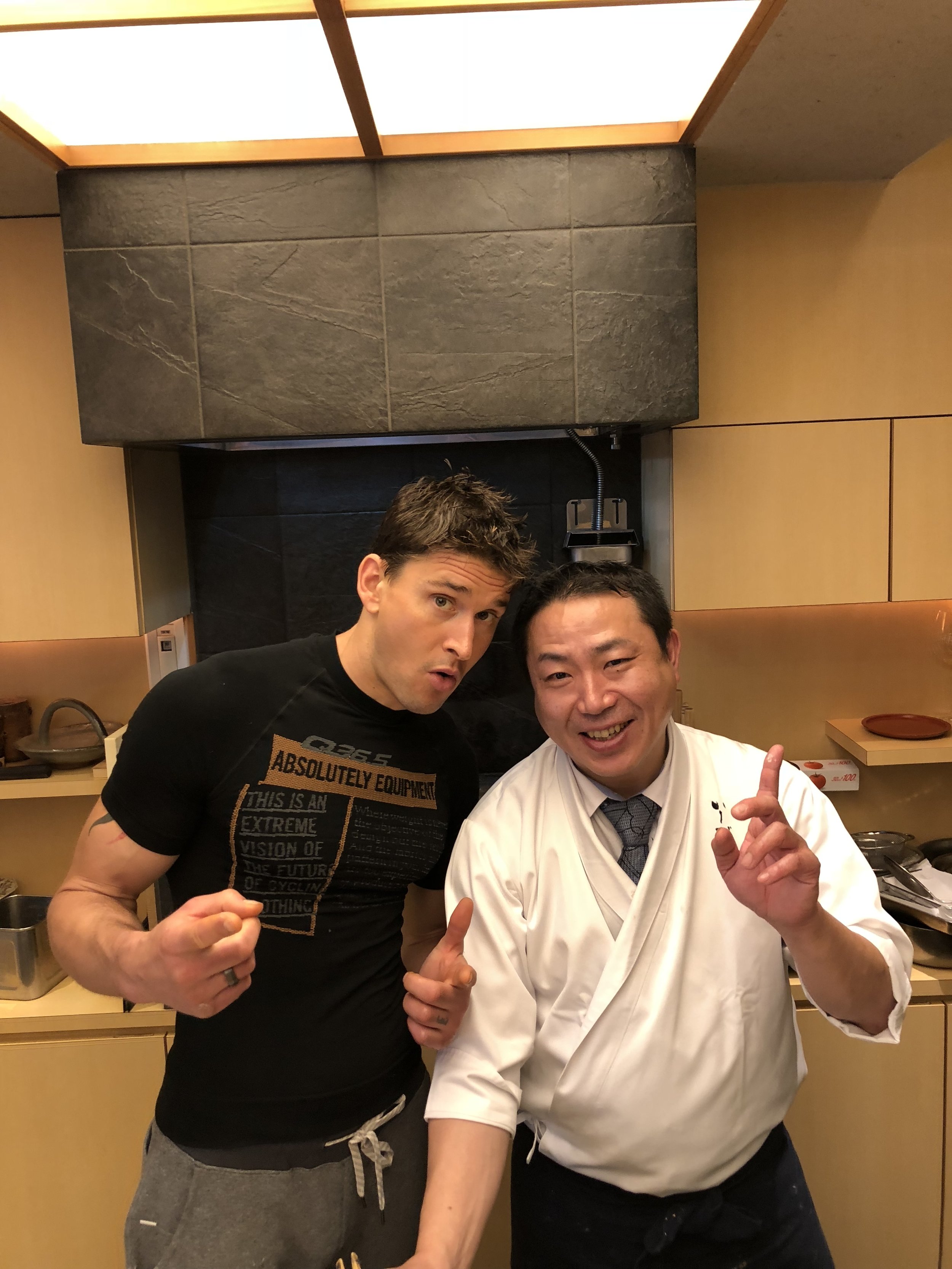
How to make Dashi (stock)
Ben has learned 2 different types. Katsuo-dashi (Bonito stock) and Iriko-dashi (dried sardine stock) Dashi is a class of soup and cooking stock used in Japanese cuisine. Dashi forms the base for miso soup, clear broth, noodle broth, and many kinds of simmering liquid. Dashi provides an authentic taste of Japan. Its an essential ingredient at the heart of Japanese cuisine, and you can try it in everything from soups to simmered dishes and dipping sauces.
Sakizuke 先附(appetizer)
Boiled vegetables marinated with tofu paste. Broccoli, asparagus, cucumber, shitake mushroom and figs are marinated with tofu and pinuts paste. In Japanese, shira-ae means “marinated in white style“ tofu and pine nuts make an elegant white sauce for this appetizer.
savory egg custard “chawanmushi“ 茶碗蒸し
Mushimono 蒸し物
Savory egg custard “chawanmushi“ (literally meaning "tea cup steam" or "steamed in a tea bowl") is an egg custard dish in Japan. Unlike many other custards, it is usually eaten as a dish in a meal, as chawanmushi contains savory rather than sweet ingredients. The custard consists of an egg mixture flavored with soy sauce, dashi, and mirin, with numerous ingredients such as shiitake mushrooms, shrimp, chicken, yuri-ne (lily root), and ginkgo placed into a tea-cup-like container.
Mukozuke (seasonal sashimi) 向付
Mukouzuke 向付
Chef Ishizuka gave us a special service, which was seasonal sashimi for me and Ben because he wants Ben to learn how Japanese chef prepare sashimi fish. Many non Japanese, I mean some Japanese too, think sashimi is just fresh raw fish, however, each fish has different flavor and umami, so each way of preparation is different. Some fish are wrapped with kombu, which has tons of flavor, and other fish are cooked only skin to get rid of fishy smell.
Agedashi Tofu and Shrimp tempura
Futamono 蓋物
Agedashi Tofu is one of those magical dishes where a few simple ingredients come together in a harmonizing synergy that elevates the dish from humble to divine. It's made with blocks of soft tofu that are coated in a thin layer of potato starch before being lightly fried. Then, the tofu is served in a savory dashi broth, but this dashi broth is very iregular because chef made it sticky for crispy surface of fried tofu. Ben did amazing job at making shrimp tempura!
Yakimono 焼き物 Grilled rock fish with yuzu citrus flavor
Yakimono 焼き物
Grilled rock fish wioth Yuzu citrus flavor. Rock fish was marinated in soy sauce and grilled in Japanese binchotan, log-shaped charcoal made from a variety of oak that combines the best aspects of lump charcoal and briquettes. Like lump coal, it burns blazing-hot—up to 900 degrees. This can not be reproduce faithfully in U.S because Japanese chacoal is very different (Yes, of course expensive. You gotta go to NYC) The principal ingredients of "yakimono (grilled foods)" are fish, shellfish, meat and vegetables. Foods are pierced with a skewer or placed on a wire net and grilled over an open fire. "Yakimono" may also be made using an iron skillet or oven broiler. The basic type of "yakimono" is "shioyaki", in which salt is sprinkled over the food before grilling, but this time, marinated fish by chef Ishizuka.
Gohan 御飯 Steamed rice with sweet corn cooked in a clay pot
Gohan 御飯
Steamed rice with sweet corn cooked in an earthenware pot. This earthenware is absolutely cheating. Ops, wrong word, this earthenware is the supreme. One can not speak of the culture of cuisine of Japan without mentioning donabe, earthenware pots. Called the oldest pottery in the world, it has been produced from the Jomon period of Japan, over 10,000 years ago, until now, the 21st century. The attractiveness of Donabe is that it has a robustness, while being pottery, that allows for it to be put on a flame when preparing food as well as having a feel and beauty that pots made from metals do not possess. Therefore, through being a utensil for cooking with superior functionality, it can create a cuisine of rich and abundant flavors, and by serving dishs in it itself, one can enjoy cuisine while also enjoying its beauty as a ceramic utensil that is a work of art.
Ishizuka uses Donabe from Kumoigama are made from select earth, one by one by the hands of a craftsman, and have a the highest level of quality and an incomparable beauty. You can buy Kumoigama by Ippentou Nakagawa in US. I wish I have a kumoigama donabe.
Gohan, Ko no mono, Tome wan 御飯、 香の物、 止椀 Rice, pickled vegetables, miso soup
Ko no mono 香の物
Tome wan 止椀
We finished meal with Japanese 101. Rice, miso soup and pickled vegetables. This is how you finish Kaiseki Japanese cusine. kaiseki is a type of art form that balances the taste, texture, appearance, and colors of food. To this end, only fresh seasonal ingredients are used and are prepared in ways that aim to enhance their flavor. Local ingredients are often included as well. Finished dishes are carefully presented on plates that are chosen to enhance both the appearance and the seasonal theme of the meal. Dishes are beautifully arranged and garnished, often with real leaves and flowers, as well as edible garnishes designed to resemble natural plants and animals.
Chef Ishizuka and Ben
We had such a wonderful time at Ginza Ishizuka. Ben learned and cooked a lot. I was very busy for taking pictures and movies, but chef Ishizuka served me one he cooked!(Ben mostly ate what he cooked) He is absolutely professional and very friendry. Ben asked him a lot of question and he tried to answer in English as much as he can. I did see not only his experience, but true passion to share his knowledge and Japanese food culture to non Japanese people. Next time I want to visit this place for my private.
With a good connection to the place of production, before a direct delivery from the producer, he visits the producing area of sashimi and negotiates the method how to cut the fish with the fishermen in person. Although there is only one course provided, the chef communicates with the guests positively to create the cuisine together. Ginza Ishizuka provides more than 15 kinds of sake, includes the brand which is difficult to obtain. You can enjoy the freshest seasonal ingredients in this extraordinary atmosphere. Without fail or doubt, here is an ideal place for business meal or to invite important guests.
Ginza Ishizuka
1-13-8, Ginza, Chuo-ku, Tokyo 1-minute walk from Ginza Itchome station (Exit 10), Yurakucho Line
TEL. 03-6228-6908 (+81-3-6228-6908)
【Business Hours】
Monday - Friday Night: 17:30 - 23:00(L.O.21:30) Saturday Night: 17:30 - 22:00
Monday - Saturday Day: 11:30 - 14:30(L.O.13:30)
【Close】
Sunday, National holidays
Ben browsing around department store in Ginza
After private cookinmg lesson/lunch, we walk walk walk in Ginza. We stopped by few department stores (there are a lot!) and Ben enjoyed seeing Japanese grocery and gift store. Depachika (meaning basement of department store) are expansive, dazzling food halls that lurk beneath each of Tokyo's major department stores, where vendors sell everything from bento boxes for lunch to formal gifts like green tea or nori packaged in fancy tins to everyday groceries. Gifts are a huge business at depachika. They're traditionally given twice a year in Japan — during summer and at the end of the year — as well as when visiting family and friends or to celebrate a special occasion. Popular options include alcohol, attractively packaged sweets, and flawless seasonal fruit like mangos, cherries, grapes, and muskmelons, presented in wooden boxes. Ben got gift for his family and I was happy for him.
We stopped by at good local coffee shop and enjoyed mid day coffee and did some work. Funny story, Ben suddenly stood up and I imediately thought that he was about to do jumping jack. Guess what? Bingo! I stood up and did some shadow boxing because we didn’t want to be too much sedentary. We were absolutey strangers in middle of Tokyo.
Dinner
After mid day work at coffee shop in Ginza, we walked to Tokyo tower area. That was pretty dicent distance. As you read this blog, both of us just keep eating, but actually not. all we had at Ishizuka was very meaningful portion and have been walking all day long. Real party is about to start now! I was so excited because my manager in Japan/ CEO of Sports Gain I work for, come and have a dinner with us. I chose this place for the last night dinner. The restaurant features beautiful pine trees and a pond where Koi carp swim. Passing in front of the garden lantern and waterwheel and walking on the steppingstones, you will find yourself back in time in the town of Edo, the Tokyo of 200 years ago. We enjoyed the extraordinary atmosphere in the restaurant with extensive Japanese gardens located at the foot of Tokyo Tower.
Ben got surprised by private room!
We were escorted to a private room where we were presented with each dish separately to examine and taste in private. Each dish is presented with the highest form of presentation and taste.
Ukai’s homemade tofu is crafted with high-quality soybeans and spring water, and has a rich and sweet taste. Tosui-tofu, which is made by putting tofu in Tosui soup created by adding dashi to soymilk,
and age-dengaku, which is made by frying sliced-tofu and then cooking it with wood charcoal, are two of their specialties. Tofu is the main dish in any course menu, and we enjoyed seasonal seafood and vegetables. Sorry, too much isoflavone, but they use organic and prepare tofu in traditional way, which is soakin soy beans and sprouted and digestable. I hope Ben won’t get man boob.
Tokyo Tower from view at Ukai
Nestled in a city environment near the Tokyo tower. This place is in a world all its own. The moment you walk through the gates you find yourself in another world were city noise disappear and you come face to face with a well kept garden, tranquility and calmness takes over your senses. The menu is seasonal and every dish is carefully selected and delicious. The food was wonderful - a mixture of vegatables, tofu, seafood and meat. The service was very good too. The staff were attentive and informative. Kazumi, my manager, opened “Dassai” ultra popular brewery in Japan has a huge following and for good reason – they make great sake. Ben liked different types of sake including Dassai. It was the last night we all enjoyed precious time in Tokyo.
I talked a lot with Ben and couldn’t believe I had spent time with this guy in my home town. His contents such as podcast, blog, shared articles and his friends who are top professional at each field have been inspiring me and I have learned more than when I was in Master’s program. My focus right now is professional MMA career, but someday I want to be a professional like a Ben, who follows ansestor’s wisdom and modern science in order to make people’s life healthy and happy. Thanks for this opportunity and Thanks Ben for coming to Japan!
Tokyo Shiba Tofuya Ukai
4-4-13 Shiba-koen, Minato-ku, Tokyo 105-0011
TEL. 03-3436-1028 +81-3-3436-1028
【Business Hours】
Weekday lunch 11:45 a.m. to 3:00 p.m. (last order)
Weekday dinner 5:00 p.m. to 7:30 p.m. (last order)
Saturdays, Sundays, and national holidays: 11:00 a.m. to 7:30 p.m. (last order)
【Close】
Regular holidays: Twice a month on Monday, year-end and New Year holidays
Tokyo Shiba Tofuya Ukai
-
Biohacking
4
- Oct 31, 2019 Upgraded Dinner Helsinki 2019
- Nov 4, 2019 First time in Lapland
- Nov 5, 2019 Helsinki 2019
- Nov 6, 2019 Short Stay in London
-
Gourmet
1
- Jul 28, 2019 TIME OUT Market Boston
-
Japan
4
- Sep 7, 2018 Ben Greenfield in Tokyo #1
- Sep 9, 2018 Ben Greenfield in Tokyo #2
- Sep 10, 2018 Ben Greenfield in Tokyo #3
- Sep 11, 2018 Ben Greenfield in Tokyo #4
-
MMA
1
- Oct 19, 2019 UFC Boston
-
Private
35
- Aug 27, 2018 Unplugged
- Sep 7, 2018 Ben Greenfield in Tokyo #1
- Sep 9, 2018 Ben Greenfield in Tokyo #2
- Sep 10, 2018 Ben Greenfield in Tokyo #3
- Sep 11, 2018 Ben Greenfield in Tokyo #4
- Feb 27, 2019 Kamakura Boston
- Apr 26, 2019 Gala Dinner of The Japan Society of Boston
- Apr 27, 2019 MAPS 2019 Awards Gala
- Jun 1, 2019 15 Years
- Jun 16, 2019 Hideru in Boston
- Jul 28, 2019 TIME OUT Market Boston
- Aug 4, 2019 Boston Skyline Views
- Aug 11, 2019 Tanglewood Boston Symphony Orchestra 2019
- Aug 18, 2019 Unplugged 2019
- Nov 4, 2020 Welcome to the world “Lumi”
- Oct 18, 2021 Back to Japan after 3 years
- May 3, 2022 A Biohacker's Journey: Exploring Estonia and Virtual Realities
- Jun 1, 2022 Optimized Day Workshop Helsinki 2022
- Jun 2, 2022 Upgraded Dinner Helsinki 2022
- Jun 5, 2022 Upgraded Offsite Helsinki 2022
- Jun 26, 2022 My Journey with Kyle Bochniak
- Aug 22, 2022 A Summer of Music and Memories
- Sep 19, 2022 Welcome to the world “Lui”
- Oct 12, 2022 Optimized Day Workshop Amsterdam 2022
- Oct 14, 2022 Upgraded Dinner Amsterdam 2022
- Oct 17, 2022 A Biohacker's Journey: Amsterdam 2022
- Dec 19, 2022 Exploring Biohacking in Japan
- Mar 19, 2023 SXSW 2023
- May 14, 2023 Recharging in Nature after a Biohacking Retreat
- Aug 26, 2023 Zen Musicianship Transcends Boundaries in France
- Aug 29, 2023 Blending Work and Family in France
- Sep 3, 2023 An Ancestral Journey: Biohacker Summit London After Party
- Oct 24, 2023 Optimized Day Workshop Amsterdam 2023
- Oct 26, 2023 Upgraded Dinner Amsterdam 2023
- Nov 4, 2023 A Biohacker's Chronicle: Amsterdam 2023
-
Rio
15
- Jul 26, 2015 Rio 1 -Rescued a wild bird-
- Aug 2, 2015 Rio 2 -Fledge?-
- Sep 17, 2015 Rio 3 -Showering Flying Surfing-
- Oct 24, 2015 Rio 4 -Pecking everything-
- Dec 27, 2015 Rio 5 -Lazy Sunday-
- Mar 3, 2016 Rio 6 -Like a Cat-
- Apr 6, 2016 Rio 7 -Dust bath on my head-
- May 19, 2016 Rio 8 -Deep Sleep-
- May 29, 2016 Rio 9 -Nail Salon by Tateki-
- Jul 5, 2016 Rio 10 -Reading with Rio-
- Sep 25, 2016 Rio 11 -Life with Rio-
- Nov 17, 2016 Rio 12 -Cage Free-
- Nov 27, 2016 Rio 13 -Recovery Day-
- Apr 21, 2017 Rio 14 -Hot and Cold-
- Jul 17, 2019 Rio got a brother? or Sister?
-
Sketch
2
- Dec 19, 2016 What to sketch -do it now, think later-
- Apr 23, 2017 Sketch Now Think Later
-
Travel
9
- Nov 5, 2019 Helsinki 2019
- Nov 6, 2019 Short Stay in London
- Jan 29, 2020 Barcelona 2020 Day1
- Jan 30, 2020 Barcelona 2020 Day2
- Jan 31, 2020 Barcelona 2020 Day3
- Feb 1, 2020 Barcelona 2020 Day4
- Feb 2, 2020 Barcelona 2020 Day5
- Feb 3, 2020 Barcelona 2020 Day6
- Feb 4, 2020 Barcelona 2020 Day7
-
Japan
1
- Dec 9, 2022 Biohacker Center meets Japanese “Mr. Internet“
-
NEWS
59
- Aug 31, 2014 Traveled a Unique Path to UFC Debut at Fight Night 50
- Sep 7, 2014 UFC Fight Night 50 Sponsorship
- Nov 24, 2014 UFC Fight Night 59 in Boston
- Jan 19, 2015 UFC Fight Night 59 Sponsorship
- Sep 1, 2015 Muay Thai Program at Fenix BJJ
- Oct 24, 2015 Fight Announcement
- Dec 28, 2015 Thanks for Support in 2015
- Jan 1, 2016 Happy New Year 2016
- Jan 8, 2016 Legacy Fighting Championship 51
- Jan 18, 2016 Tateki's Fighting Expedition
- Jan 23, 2016 The Total Human Optimization
- Feb 6, 2016 Legacy 51
- Jul 29, 2016 Fight Announcement Pancrase 280
- Sep 11, 2016 Pancrase 280
- Nov 13, 2016 Cats out of the "pads" !
- Dec 26, 2016 Let's Burn Off
- Jan 30, 2017 Fight Announcement Pancrase 285
- Mar 13, 2017 Pancrase 285
- Sep 11, 2017 Shoulder surgery
- Sep 19, 2017 How to Achieve a Lifetime of Sustained Peak Performance
- Apr 17, 2018 Own the Day, Own Your Life
- May 8, 2018 Fight Announcement Pancrase 297
- Jul 2, 2018 Pancrase 297
- Sep 8, 2018 TB12 VIBRATING PLIABILITY ROLLER
- Oct 6, 2018 Lessons
- Jan 1, 2019 Fight Announcement CES 54
- Jan 20, 2019 CES 54
- Mar 30, 2019 TECH by Champion
- Jun 23, 2019 Fight Announcement CES 57
- Jul 27, 2019 CES 57
- Aug 16, 2019 TB12 Vibrating Pliability Sphere
- Sep 17, 2019 Red Carpet at the TB12 Boston opening party
- Nov 6, 2019 Partnership with Biohacker Center BHC Inc
- Jan 1, 2020 Fight Announcement Cage Titans XLVII
- Jan 26, 2020 Cage Titans 47
- Apr 30, 2020 Be healthy with Vessi
- Jul 20, 2020 TB12 Vibrating Pliability Mini Sphere
- Mar 17, 2021 Tsurumen Inc
- May 13, 2021 The manufacture of San J in Virginia
- Nov 30, 2021 Corporate wellness Program in Japan
- Dec 13, 2021 Biohacker Center Japan Press Release
- Feb 5, 2022 GF Ramen is available at Tsurumen
- Mar 19, 2022 XMMA fight announcement
- Apr 3, 2022 XMMA4
- Apr 10, 2022 Biohacker’s Retreat 2022
- May 21, 2022 Speaking at Biohacker Summit in Helsinki
- Jun 7, 2022 Biohacker Summit Helsinki 2022
- Jun 26, 2022 Monthly Article by Tateki on Hakkohub
- Jul 9, 2022 Bankless Monk
- Aug 18, 2022 Speaking at Biohacker Summit in Amsterdam
- Oct 19, 2022 Biohacker Summit Amsterdam 2022
- Dec 9, 2022 Biohacker Center meets Japanese “Mr. Internet“
- Mar 19, 2023 Bankless Monk at SXSW 2023
- Apr 28, 2023 Biohacker’s Retreat in Estonia 2023
- Aug 16, 2023 Warm up event in London
- Aug 20, 2023 GF Ramen Lab Noodles Now Available on Amazon
- Sep 6, 2023 Biohacker Summit 2023 London
- Oct 1, 2023 Unlocking Movement's Mysteries at the Biohacker Summit
- Nov 5, 2023 Biohacker Summit Amsterdam 2023 Recap
-
Private
4
- Dec 31, 2018 Keep Going
- Jan 1, 2020 Thanks 2019 & Happy New Year 2020
- Jan 1, 2021 Thanks 2020 & Happy New Year 2021
- Jan 1, 2022 Thanks 2021 & Happy New Year 2022
-
Biohacking
10
- Jun 4, 2018 Mushroom Coffee
- Aug 1, 2018 keto box
- Mar 17, 2019 Keto Mojo
- Nov 2, 2019 Biohacker Summit Helsinki 2019
- Jun 4, 2022 Biohacker Summit Helsinki 2022
- Oct 16, 2022 Biohacker Summit Amsterdam 2022
- May 1, 2023 Biohacker’s Retreat April 2023
- Sep 4, 2023 Biohacker Summit London 2023 Show notes
- Sep 18, 2023 Biohacker’s Retreat September 2023
- Oct 29, 2023 Biohacker Summit Amsterdam 2023 Show Notes
-
Coffee
2
- Jun 4, 2018 Mushroom Coffee
- Aug 1, 2018 keto box
-
Earthing
1
- Jun 7, 2019 Earth Runner
-
Gut health
1
- Jul 2, 2019 Viome
-
Injury
8
- Sep 11, 2017 Determination
- Sep 29, 2017 Week 3
- Oct 6, 2017 Week 4
- Oct 13, 2017 Week 5
- Oct 30, 2017 Week 6 & 7
- Nov 13, 2017 Week 8 & 9
- Nov 26, 2017 Week 10 & 11
- Dec 30, 2017 After Week 12
-
Nutrition
10
- Jun 4, 2018 Mushroom Coffee
- Aug 1, 2018 keto box
- Jun 26, 2022 Fermented Foods for Health Optimization
- Aug 10, 2022 Fermented Foods for Immune System
- Oct 2, 2022 Fermented Foods for Healthy Skin
- Nov 7, 2022 Japanese Drinkable IV “Amazake”
- Dec 23, 2022 “Mirin” Sweet Rice Sake Beyond Seasoning
- Jan 29, 2023 Eat “Cultural Heritage.” Osechi Japanese New Year’s Food
- Mar 12, 2023 Fermentation Makes Processed Meat Different
- Apr 13, 2023 Cheese and Your Health: The Impact of Fermentation, Type, and Production Method
-
Performance
3
- Aug 12, 2018 First time Spartan Race
- Aug 14, 2019 Boston Super and Sprint Weekend 2019
- Nov 9, 2019 Spartan race Boston at Fenway Park 2019
-
Recovery
2
- Sep 11, 2016 REhydration Process
- May 15, 2019 BIO CBD plus
-
Rehabilitation
8
- Sep 11, 2017 Determination
- Sep 29, 2017 Week 3
- Oct 6, 2017 Week 4
- Oct 13, 2017 Week 5
- Oct 30, 2017 Week 6 & 7
- Nov 13, 2017 Week 8 & 9
- Nov 26, 2017 Week 10 & 11
- Dec 30, 2017 After Week 12
-
Strength & Conditioning
10
- Jun 20, 2014 MMA Fight Prep 1
- Jun 21, 2014 MMA Fight Prep 2
- Jun 23, 2014 MMA Fight Prep 3
- Jun 23, 2014 MMA Fight Prep 4
- Jun 24, 2014 MMA Fight Prep 5
- Aug 27, 2014 Hit some Swings
- Feb 10, 2015 No Season for MMA Fighters
- Apr 10, 2015 Random Day of my Training
- May 29, 2015 Dropping a Weight Class
- Feb 21, 2016 Conditioning during Fight Week
-
Strong First
1
- Aug 13, 2016 SFG Level 1 Test
-
Supplement
3
- Jun 4, 2018 Mushroom Coffee
- Aug 1, 2018 keto box
- Dec 10, 2018 Complete Nutrition with Bits
-
Tatekitchen
- May 14, 2023 Biceps Rissoto
- Feb 14, 2023 Chicken Confit
- Jan 31, 2023 Wild Boar with Wagyu Ragù
- Jan 8, 2023 Lobster and Salmon Roe Pasta
- Jan 7, 2023 “Okuizome” (first meal) for Lui
- Jan 1, 2023 Osechi 2023
- Dec 25, 2022 French Cassoulet 2022
- Dec 24, 2022 Duck breast marmalade
- Nov 24, 2022 Thanksgiving 2022
- Nov 19, 2022 Buffalo Testicle
- Nov 6, 2022 Meal Prep for my Family
- Aug 21, 2022 Pescatore Boston
- Aug 14, 2022 Mussels Italian Style
- Aug 12, 2022 Steak with foie gras
- Jan 31, 2022 Capon Covered with Caul Fat
- Jan 1, 2022 Osechi 2022
- Dec 25, 2021 French Cassoulet 2021
- Dec 24, 2021 Duck breast Balsamic vinegar glaze
- Nov 25, 2021 Thanksgiving 2021
- Sep 18, 2021 Pigeonneau (squab)
- Sep 12, 2021 Summer Salad
- Jul 25, 2021 Bison Bulgogi
- Jul 18, 2021 Bison Bolognese
- Jul 4, 2021 Epic Surf & Turf
- Jun 26, 2021 OMAD
- May 7, 2021 Pan Seared Pork Chops
- Apr 25, 2021 Rice malt marinated NY strip steak
- Apr 17, 2021 Pasta & Salad
- Mar 6, 2021 Lamb Ribs with Blackcurrant sauce
- Mar 3, 2021 Chicken with Mustard Butter Sauce
- Feb 26, 2021 Joi's Ginisang Pechay with Ground Pork and Shrimp
- Feb 14, 2021 “Okuizome” (first meal) for Lumi
- Jan 31, 2021 Slow Braised Wild Bore
- Jan 1, 2021 Osechi 2021
- Dec 25, 2020 French Cassoulet 2020
- Dec 24, 2020 Sauteed Duck breast with Foie Gras
- Nov 26, 2020 Thanksgiving 2020
- Sep 20, 2020 Buffalo Testicles Stew
- Aug 16, 2020 Beef Tongue Stew
- Jun 16, 2020 Kitchari Cleanse
- May 9, 2020 Tagliatelle con Gamberi e Melanzane
- Feb 15, 2020 Pasta Negra con Langostinos
- Feb 14, 2020 Salted Cod on Carrot Purée
- Dec 28, 2019 New England Favorite
- Nov 28, 2019 Thanksgiving 2019
- Aug 4, 2019 Buffalo Spleen
- May 12, 2019 Pichania
- Mar 29, 2019 Probiotic Sour Soup
- Feb 14, 2019 Uni carbonara
- Jan 31, 2019 Faisan rôti
- Nov 23, 2018 Thanksgiving 2018
- Oct 22, 2018 Short Rib or Vegan Bolognese
- Jun 18, 2018 Meatless Monday
- May 5, 2018 Venison Medley
- Jan 31, 2018 Beef tongue
- Jan 1, 2018 New year 2018
- Dec 25, 2017 Cassoulet
- Nov 20, 2017 Fermented Foods
- Sep 2, 2017 Crépinette
- Jul 16, 2017 Sourdough Bread
- May 7, 2017 Kombucha Challenge
- Apr 28, 2017 Keto Meal Ideas
- Apr 3, 2017 Miracle Noodles
- Jan 31, 2017 Braised lamb belly
- Jan 7, 2017 Venison Steak
- Dec 9, 2016 Beaujolais nouveau & Venison
- Oct 16, 2016 Gibier and Bordeaux
- Sep 20, 2016 Lapin Braisé à la Bière
- Jul 16, 2016 Opus One 2008
- Jul 3, 2016 Meatless Meatball
- Jul 1, 2016 Paleo Friendly Plate
- May 22, 2016 Le Fromage de Tête
- May 6, 2016 Gluten Free Challenge 4
- Apr 28, 2016 Spaghetti Squash
- Apr 21, 2016 Intermittent Fasting
- Apr 16, 2016 Potée
- Apr 14, 2016 Sauerkraut
- Mar 27, 2016 Gluten Free Challenge 3
- Mar 18, 2016 Detox Pasta
- Feb 24, 2016 COTELETTES D'AGNEAU
- Feb 21, 2016 Ratatouille
- Feb 9, 2016 Atelierkitchen Zen 3
- Jan 21, 2016 Galette for Cheat Meal
- Jan 14, 2016 Zucchini Pasta
- Nov 30, 2015 Filet de Canard à la grenade
- May 24, 2015 Osso Bucco lamb shank
- May 7, 2015 Paella de Quinoa
- Apr 7, 2015 Gluten Free Challenge 2
- Mar 31, 2015 Gluten Free Challenge
- Mar 17, 2015 Atelierkitchen Zen 2
- Mar 11, 2015 Fegatto di Vittello al burro all'aglio
- Oct 17, 2014 Atelierkitchen Zen
- Sep 15, 2014 Duck Again!
- Aug 18, 2014 Duck is the best
- Jun 16, 2014 Caramelized Pork belly
- Jun 9, 2014 Monkfish Risotto
- May 27, 2014 Summer Vegetables Curry
- May 15, 2014 Beef achilles
- May 8, 2014 Crystal Clear Ramen
- Feb 3, 2014 Choux farci au Saumon (Salmon stuffed Cabbage)
NEWS
OPTIMIZED LIFE
TATEKITCHEN
BLOG














